Salvaging Tires and Providing Brilliance and Durability to Rubber
Contributed by Bryan R. Morris, Senior R&D Engineer and Nastausha Hefner, Marketing Manager, Stockmeier Urethanes USA Inc.
One of the things that has advanced the use of tire derived crumb rubber is the ability to color the rubber—not only for the aesthetics but to add durability and retain the rubber’s resiliency and other engineered and performance properties. For over 30 years, Stockmeier Urethanes has focused on producing coatings, adhesives and elastomers for industrial, sports and leisure applications.
Headquartered in Germany, Stockmeier Urethanes opened its U.S. facility in Clarksburg, West Virginia in 2004 to service its U.S. raw material suppliers and U.S. markets. Located on a four-acre site, the Clarksburg facility houses a manufacturing complex that includes a research and development lab, manufacturing and production equipment and operations as well as a shipping and distribution unit.
Finding methods to mitigate the materials that go into landfills is critical to the health of our communities. Before tires were recycled and utilized to make colored rubber for playgrounds, mulch and a variety of other consumer goods, they were most often diverted to landfills.
 Today, tire recyclers and tire-derived rubber products manufacturers have the ability to create eye-appealing, durable and high performing recycled rubber products in a range of colors for everyday use and applications in domestic, commercial and industrial markets.
Today, tire recyclers and tire-derived rubber products manufacturers have the ability to create eye-appealing, durable and high performing recycled rubber products in a range of colors for everyday use and applications in domestic, commercial and industrial markets.
Stockmeier Urethanes’ Stobielast® S polyurethane (PUR) coatings for recycled rubber are pre-pigmented and moisture cured. Utilizing only the highest UV-stable pigments and specialized dispersion processes, these materials provide high hiding-power at low consumptions with a variety of color options.
As a commitment to the Stockmeier’s continued efforts towards sustainability, these products incorporate renewable, bio-based materials. Competitive technologies in the market are water-based polymers of varying chemistry and require special drying equipment to avoid streaking in the packaging and microbial attacks during storage. In addition, many of the water-based materials offer poor abrasion resistance during processing which results in loss of coating during mixing and loss of color for the consumer. Reduction of inventory, more consistent color, ease of addition, cleanliness and efficiency of processing, and outstanding durability are key process benefits of using pigmented PUR coatings, Stockmeier Senior R&D Engineer said.
Polyurethane is more than a coating that dries on the rubber. PUR chemically crosslinks and encapsulates the rubber which makes it the product of choice for performance. There are three principal methods for coloring rubber with polyurethane.
The loose rubber can be colored with solid pigments that are added during mixing. The solid pigments are then encapsulated with a clear, moisture-cure PUR. Solid pigments are high in cost and add additional complexity to the coloring process. In addition to having to add multiple pigments to achieve certain colors, some pigments require specialized wetting for full intensity. This often cannot be achieved by simple blending with the rubber and PUR and more pigment is required. Additionally, not all pigments are UV stable and may result in loss of color over time.
In another method, the loose rubber is colored with a liquid pigment-dispersion and then encapsulated with a clear, moisture-cure PUR. Though far less prone to the issues described in method one, additional inventory and processing inconsistencies and times are still a factor for consideration
In the third method, the loose rubber is both colored and encapsulated with a pre-pigmented, moisture-cure, PUR coating. The polyurethane, stabilizers and pigments are all built into one product and excess inventory, inconsistent color and expensive drying equipment are eliminated. This has been the process of choice increasingly over the last decade as the full benefits have been realized.
Stockmeier Urethanes uses proprietary catalysts that snap cure the PUR coatings and eliminate the need for a heating tunnel or any other exterior drying tools.
The quality of the rubber feedstock, the mixer used for the coating process and proper agitation of the coating are critical factors for successfully coloring recycled rubber.
“The cool thing about this market is that converting end-of-life tires to crumb rubber and buffings allows for the tires to be diverted from landfills reducing environmental concerns and be transformed into commodities that create jobs and add revenue to the economy. By enhancing and adding value to recycled rubber, Stockmeier further advances its commitment to eliminate landfill disposal of tires, protect the environment and create sustainable recycled rubber products that improve quality of life worldwide”, Morris said.
© Scrap Tire News, November 2023






